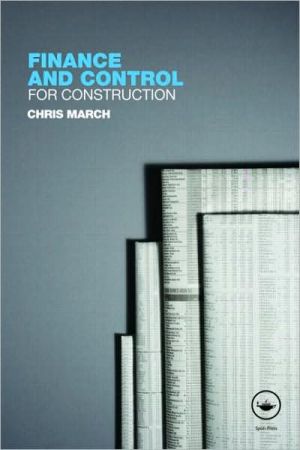

 |

|

Sold Out
Book Categories |
List of figures x
List of tables xi
Introduction 1
1 The development process: the main participators 4
1.1 Landowners 4
1.2 Private developers 7
1.3 Public-sector and government agencies 8
1.4 Planners 9
1.5 Financial institutions 10
1.6 Agents 10
1.7 Building contractors 11
1.8 Project design and development team 11
1.9 Objectors 18
1.10 Occupiers 19
2 Sources of finance 21
2.1 Insurance companies and pension funds 21
2.2 Banks 22
2.3 Private person 23
2.4 Building societies 23
2.5 Government and EC funding 23
3 Valuation and development appraisal 25
3.1 Introduction 25
3.2 Cost elements 26
3.3 Development valuation techniques 34
3.4 Risk analysis and sensitivity analysis 39
3.5 Mathematics of valuation 42
4 Introduction to design economics 47
4.1 RIBA Plan of Work 47
4.2 Factors affecting the cost of the building 49
5 Approximate estimating 55
5.1 Introduction 55
5.2 Methods 55
5.3 Functional unit method 56
5.4 Superficial area method 56
5.5 Elemental cost plan 57
5.6 Approximate quantities techniques 57
6 Whole-life costing and life-cycle assessment 61
6.1 Definitions 61
6.2 Introduction 61
6.3 Cost centres 63
6.4 Period of analysis 63
6.5 Factors affecting life expectancy 64
6.6 Data for whole-life costing 67
6.7 Issues to be considered at the design stage for whole-life costing 68
6.8 Is whole-life costing effective? 72
6.9 Life-cycle assessment 73
6.10 Whole building environmental assessment 74
6.11 The future and sustainable building development 76
7 Value management or engineering 78
7.1 Introduction 78
7.2 Functional performance 79
7.3 Methodology or sequence of events80
7.4 When valuation engineering should be applied 84
7.5 Functional analysis method 84
7.6 Function cluster groups 85
8 Procurement methods and types of contract 88
8.1 Traditional methods of procurement 89
8.2 Design and build 91
8.3 Construction management 92
8.4 Management contracting 94
8.5 Partnering 94
8.6 Alliancing 97
8.7 Private-Public Partnerships and Private Finance Initiatives 98
8.8 Prime costing 98
8.9 ProCure21 99
8.10 Apportioning risk 100
9 Standard Method of Measurement and bills of quantities 102
9.1 Introduction 102
9.2 The Standard Method of Measurement 102
9.3 Composition of SMM7 103
9.4 Preliminaries 105
9.5 Preliminaries classification expounded 106
9.6 The bills of quantities 122
10 Estimating and tendering procedures 125
10.1 Introduction 125
10.2 Selection and invitation to tender 127
10.3 Tender documentation 128
10.4 The decision to tender 129
10.5 Managing the estimating process 131
10.6 Completing the bills 134
10.7 Building up the costs of an item 134
10.8 Calculating labour costs 135
10.9 Building up material rates 144
10.10 Cost of plant 148
10.11 Calculating and pricing unit rates 151
10.12 Costing the preliminaries 151
10.13 Sub-contractors' and suppliers' quotations 164
10.14 Selection and invitation to tender - sub-contractors 169
10.15 Opening of tenders 170
10.16 Suppliers' quotations 172
10.17 Method statements 173
10.18 Tender programme 175
10.19 Cash flow 176
10.20 Overheads and profit 176
10.21 Bringing the tender information together for final review 180
10.22 Final review meeting 183
10.23 Final adjustments and submitting the tender documents 185
10.24 Vetting of tenders 187
10.25 Risk and uncertainty in estimating 188
10.26 Computerised estimating 190
11 Bidding strategy 194
11.1 Introduction 194
11.2 Comparisons with competitors 195
11.3 The accuracy of the estimate 196
11.4 The number of competitors 198
11.5 Summary 199
12 Purchasing 200
12.1 Introduction 200
12.2 Ethics 200
12.3 Fair price 203
12.4 Procedures for procuring suppliers and sub-contractors 204
12.5 Preferred suppliers and sub-contractors 204
12.6 Supply chain management 205
13 Post-contract cost control 206
13.1 Introduction 206
13.2 Pareto's Law 206
13.3 The basic needs of a cost-control system for the contractor and client 207
13.4 Cash flow 208
13.5 S-curve 209
13.6 Further refinements 209
13.7 Monitoring using the S-curve 211
13.8 Saw-tooth diagram 211
13.9 Bad practices 212
14 Interim valuation, claims and variations 214
14.1 Introduction to interim valuations 214
14.2 Sums subject to retention 214
14.3 Sums not subject to retention 215
14.4 Materials on site 216
14.5 Off-site materials 216
14.6 Introduction to claims 216
14.7 Extension of time 217
14.8 Cost centres for claims 217
14.9 Introduction to variations 221
14.10 Example calculations 222
15 Cost systems 227
15.1 Introduction 227
15.2 Budget cost 227
15.3 Actual cost 228
15.4 Direct labour costing systems 230
Index 239
Login|Complaints|Blog|Games|Digital Media|Souls|Obituary|Contact Us|FAQ
CAN'T FIND WHAT YOU'RE LOOKING FOR? CLICK HERE!!! X
 You must be logged in to add to WishlistX
 This item is in your Wish ListX
 This item is in your CollectionFinance and Control for Constuction
X
 This Item is in Your InventoryFinance and Control for Constuction
X
 You must be logged in to review the productsX
 X
 X

Add Finance and Control for Constuction, Drawing on a wealth of practical experience, both in the construction industry and teaching students, Chris March presents this study of construction management and the major aspects of controlling the building process. Covering the stages from the cli, Finance and Control for Constuction to the inventory that you are selling on WonderClubX
 X

Add Finance and Control for Constuction, Drawing on a wealth of practical experience, both in the construction industry and teaching students, Chris March presents this study of construction management and the major aspects of controlling the building process. Covering the stages from the cli, Finance and Control for Constuction to your collection on WonderClub |